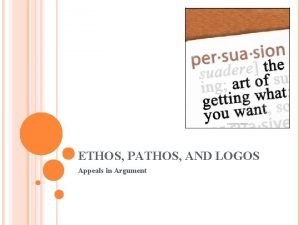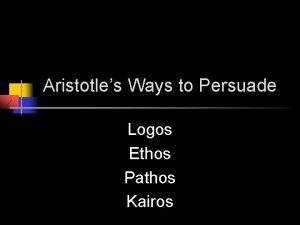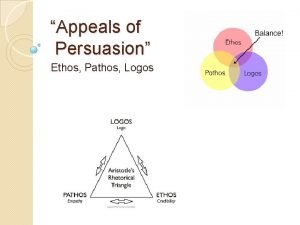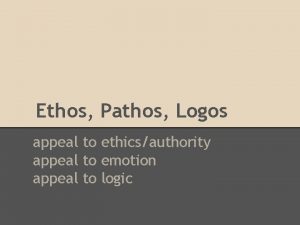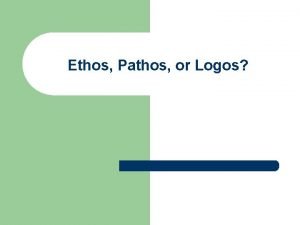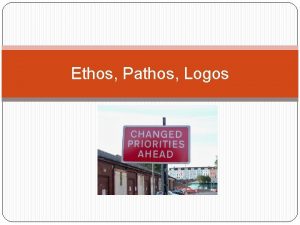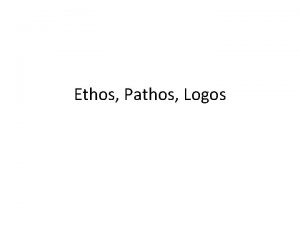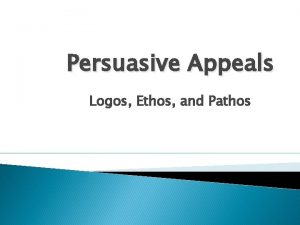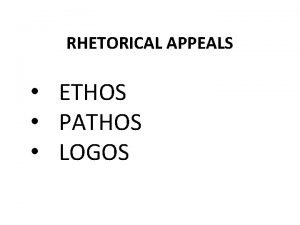Types of Logical Appeals Logos Ethos and Pathos









- Slides: 9

Types of Logical Appeals: Logos, Ethos, and Pathos

Exploring Different Types of Appeals • • Emotional (pathos) - appeals to feelings Ethical (ethos) – appeals to values Logical (logos) – appeals to reason/logic Each different rhetorical situation you find yourself in will call for you to use a different balance of these three types of appeals.

Types of Appeals: Logos • One type of appeals to your readers’ rational sides using facts and logical explanations. • This is called logos, which is related to the word "logic. “ • By making sure that your facts are relevant and well -documented, you will increase your credibility as a writer. • If an appeal uses scientific research, data, or other “cold, hard facts” to make its point, it is using logos.

Types of Appeals: Ethos • You may be appealing to your readers’ sense of what is ethical (in this context “ethical” means “the right thing to do”) by asserting that you share common values with them. An appeal to values/ethics is an appeal to ethos, which shared a root with the word “ethical. ” • If an argument is appealing to ideals or values that are important to the reader (for example, equality and fairness, “The American Dream, ” etc. ) and are shared by the writer, it is appealing to ethos.

Types of Appeals: Pathos • You may also be making an appeal to emotion. This is called pathos. It shares a root with the word "pathetic, " which originally mean “inspiring pity. ” It originally meant appealing to the emotions without the negative connotation of weakness that modern English gives it. • You are trying to get your audience to really feel for whatever cause you are arguing for. • If an argument “tugs at the heart strings” or causes the reader to emotionally engage with the topic, it is using pathos.

Balancing Logos, Ethos, and Pathos • It is your job as a writer to balance facts, values, and emotions. Too much of one and not enough of the others can make for an unbalanced argument. Be especially aware of overusing emotional appeals. People are smart, and they don't like being jerked around by their emotions. This is especially true when writing for a mixed audience… people who disagree with you will be on the lookout for emotional manipulation.

How can I use claims and appeals in my own writing? • Identify what’s at stake. • Take some time right now to ask yourself, who might be affected by my issue? Also, be on the lookout for sources who can give you more info on what’s at stake. A lot of times, we don’t know exactly what’s at stake until we do the research. • What types of appeals might be useful for you? How might you use emotion? How might you use logic? Values? • Be on the lookout for all types of appeals, or the building blocks of all types of appeals, in your sources as you read.

What is an annotated bibliography? • An annotated bibliography has two parts: • First, it is a list of Works Cited entries sources you have already read. • Second, each source is followed by two paragraphs: – One paragraph that summarizes the source's claim(s) – A second paragraphs that tells why the source is trustworthy and relevant to your question, and explains why you have chosen to use it in your research paper. What unique perspective does this source offer? Why would a quote, paraphrase, or summary from this source a valuable addition to your own writing about the topic?

Format of Annotated Bibliography • See the handout I gave you for general information about annotated bibliographies and an example annotated bibliography with three sources (remember, you will need SEVEN). There is also an example with one source on the class website. • Your annotated bibliography will need… Seven sources Each source put into MLA works cited format (as in example) Sources alphabetized Two paragraphs following each source discussing requirements on previous slide. – Please skip a line between MLA works cited entries and paragraphs. (See example. ) – –

